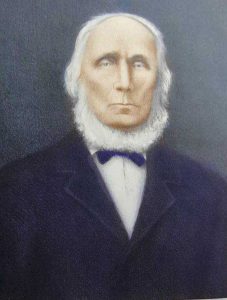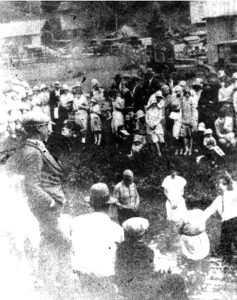A couple of weeks ago, we took a look at the T.J. George Mill in downtown Stuart. Today, we will go to Meadows of Dan to learn about Langhorne Mill and its’ owner, James “Steptoe” Langhorne.

According to a 1935 Martinsville Bulletin interview with his daughter, Fanny Langhorne Spangler, James Steptoe Langhorne moved to Meadows of Dan from Lynchburg in 1847. Langhorne had married Elizabeth Rachel Omohundro on Christmas Eve 1846, and the couple built their home along the headwaters of the Dan River in the Mountain View section of Patrick County.
Steptoe Langhorne built a mill on the Dan River and hired James Rutledge and his son, Henderson Rutledge to run it. Then the war came…. Both Rutledge, father and son, were called away to fight for the Confederacy where they were both killed in 1863, one in Gettysburg and one in Chancellorsville. I recently wrote several columns about the Rutledge family who was struck by so much tragedy during the war, including the two men’s deaths and losing eight of their thirteen children to the diphtheria epidemic that struck Patrick County in 1862. Thanks to Mr. John Martin, (the same gentleman that donated the Jeff Penn carriage to the museum), the Rutledge family letters can be viewed at the Patrick County Historical Society and Museum. Martin recently discovered the letters at an auction in Gettysburg and purchased them to donate to the museum.
Steptoe Langhorne was completely blind and needed assistance running the mill after losing the Rutledge’s, so he hired his brother-in-law, Samuel Hopkins Turner. Turner was married to Elizabeth’s sister, Ann Maria Omohundro Turner. It wasn’t long until Samuel Hopkins Turner was called up for service, so a petition filed in 1864 in Patrick County Circuit Court was sent to the Secretary of the War Department for the Confederacy. The petition stated the following: “It appears to the satisfaction of the Court, from the statements of James S. Langhorne and a petition of citizens of that portion of the county lying on the Blue Ridge, known as Meadows of Dan, that James S. Langhorne is the owner of a grist mill and saw mill situated on the Meadows of Dan, that said Langhorne is blind and unable to attend said mill, that he was also having an addition built to said mill, and that said addition is very important. That the demand for the proper operation of said mill is very great. That the stopping of the mill has caused great inconvenience to between 80 to 100 families, a very large majority are poor people who have to carry their grain on their backs at least twelve miles up and down the mountain and it is further appearing that Samuel H. Turner was the miller and millwright for said Langhorne and that he had been regularly detailed by the local board of the county as miller and remained in the discharge of his duties until taken to the army until the recent order revoking all details and that the mill cannot be operated until said Turner be detailed and sent home to take charge of it. The court, being satisfied that this mill is very important, and that Mr. Langhorne cannot employ anyone to fill the place of Samuel H. Turner, respectfully and earnestly requests the Secretary of War to detail said Turner as miller for James S. Langhorne who is blind.”

Steptoe Langhorne’s daughter, Fanny Langhorne Spangler, shared with Mr. Charles F. Adams other ways the war effort devastated the Langhorne family. The interview was published in the Martinsville Bulletin on May 27, 1935…
“At the time Miss Fanny Langhorne was ten, and the Civil War was being fought, Stoneman brought his Yankee army from Tennessee down what is now the J.E.B. Stuart highway. In passing they annexed one of Mr. Langhorne’s horses which happened to be his favorite. He, though blind, accompanied by his small daughter Fanny, insisted on following the army to Stuart in search of his horse. There the captain agreed to allow him to retrieve his horse if he could recognize him. Mr. Langhorne sent Fanny to hunt the animal. After walking down the long line of horses hitched to the racks along the road and back again, she was unable to find him. On her return, however at one side, away from the rest, she saw her father’s mount and immediately squealed in delight. Mr. Langhorne was led over to a tall roan mare, not his, but near the one Fanny had discovered, and told to see if that were his. Fanny squealed to the contrary, but Mr. Langhorne turned to her and said, “You don’t understand the joke.” Then his hand was placed on another, his own; this time he said, “This is my horse, but not my bridle.” Shortly following his return home with the horse, it was again stolen along with another by a detail of the Rebel army. Sometime after the close of the war, over in Floyd County, the horse was again found. He had received an injury in the war of such a nature that it was said that swimming him in water would cure it. It was Fanny Langhorne’s only brother who was drowned while riding the horse for this purpose.”
Henry Ellis Langhorne, the oldest child of James Steptoe Langhorne and Rachel Elizabeth Omohundro Langhorne, was born on the 7th of July 1849. His death, recorded in the Patrick County Circuit Court, states that he died from drowning on the 12th of August 1865; he was sixteen years old.
Woody may be reached at rockcastlecreek1@gmail.com or (276) 692-9626.




